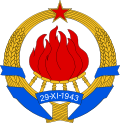- Parliament of Yugoslavia
-
Yugoslavia 
This article is part of the series:
Politics and government of
YugoslaviaExecutiveParliamentElectionsStates
The Parliament of Yugoslavia was the deliberative body of Yugoslavia. Before World War II in the Kingdom of Yugoslavia it was known as the National Assembly (Narodna skupština), while in the Socialist Federal Republic of Yugoslavia the name was changed to Federal Assembly (Serbo-Croatian: Savezna skupština / Савезна скупштина). It was the official deiberative body of the Yugoslav state, which existed from 1918 to 1992 and resided in the building which now convenes the National Assembly of Serbia.
Contents
Kingdom
The first parliamentary body of the state was the Temporary National Representation which existed until the first elections were held on 28 November 1920. The new parliament was known as the Constitional Assembly. The assembly adopted the controversial Vidovdan Constitution on 28 June 28 1921, after which it became known as the National Assembly.
During the January 6th Dictatorship, the kingdom became a constitutional monarchy and a Senate was formed in additional to the National Assembly.
AVNOJ
Main article: AVNOJSocialist Federal Republic
As a result of the Treaty of Vis, the Anti-Fascist Council of the People's Liberation of Yugoslavia was reformed into the Temporary National Assembly which also included several dozen members of the assembly elected in 1938. After the consolidation of power by the communists in late 1945, the Constitutional Assembly was established. The Constitutional Assembly was divided into two houses: the Federal Assembly, and the Assembly of Peoples.
With the adoption of a constitution in 1946, the name National Assembly was adopted again. It was divided into two councils: the Federal Council, and the Council of Peoples. In 1956, the name Federal People's Assembly was adopted divided into the Federal Council and the Council of Producers.
In 1963, the Federal Assembly was divided into five councils: the Federal Council, the Economic Council, Educational-Cultural Council, Social-Health Council and the Organization-Political Council. In 1968 the Council of Peoples was reintroduced. In 1974 the Federal Assembly was divided again into two chambers: the Federal Council and the Council of Republics and Regions.
The Federal Assembly was composed of appointed members from the League of Communists of Yugoslavia compiled from the Leagues of Communists of each constituent republic.
The Federal Assembly was bicameral, with the lower house called the Federal Chamber and upper house, the Chamber of Republics and Provinces. Federal Chamber had 30 members from each Republic and 20 from each Autonomous Province. Chamber of Republics and Provinces had 12 members from each Republic and 8 from each Autonomous Province.[1]
When the League of Communists collapsed in 1990 amid ethnic tensions, the Federal Assembly was shut down. The institution would be resurrected as the Federal Assembly of the Federal Republic of Yugoslavia in 1992, but this assembly had elected members.
See also
- List of Presidents of the Federal Assembly of the Socialist Federal Republic of Yugoslavia
- List of Presidents of the Chamber of Citizens of the Federal Assembly of Yugoslavia
- List of Presidents of the Chamber of Republics of the Federal Assembly of Yugoslavia
- Parliament of Serbia and Montenegro
- List of Presidents of the Assembly of Serbia and Montenegro
- National Assembly of Serbia - Serbia's parliament which is housed in the same building that formerly was the Federal Assembly building
- Parliamentary Assembly of Bosnia and Herzegovina
- Croatian Parliament
- Assembly of Kosovo
- Assembly of the Republic of Macedonia
- Parliament of Montenegro
- Slovenian Parliament
References
- ^ Constitution of the SFRY on WikiSource (Serbian)
Categories:- 1946 establishments
- 1990 disestablishments
- Politics of Yugoslavia
- Defunct bicameral legislatures
- Yugoslavia stubs
- List of Presidents of the Federal Assembly of the Socialist Federal Republic of Yugoslavia
Wikimedia Foundation. 2010.

